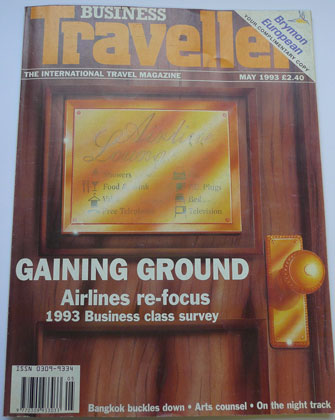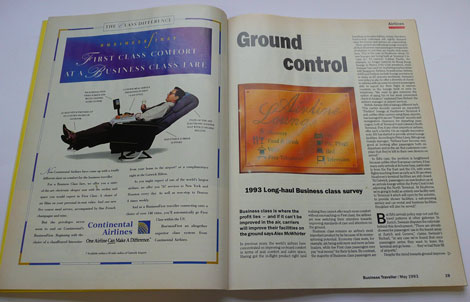Alex McWhirter looks through the Business Traveller archive. This month: A May 1993 article on business class seats
 Long-haul business class has come on leaps and bounds over the past 20 years. No other airline cabin in the sky has experienced such a remarkable change. These days, a good business class seat offers passengers a more spacious environment than a typical first class product in 1993.
Long-haul business class has come on leaps and bounds over the past 20 years. No other airline cabin in the sky has experienced such a remarkable change. These days, a good business class seat offers passengers a more spacious environment than a typical first class product in 1993.
Today’s travellers expect any reputable airline to offer fully-flat beds as a matter of course. They also want a choice of food, large TV screens and multichannel entertainment. On the ground, they demand a well-appointed lounge.
Yet in 1993, these amenities were not standard across the industry, and there were wide variations in what you could expect on the ground.
Seats did not recline very far so overnight flights could be a trial. Legroom ranged from as little as 36 inches (91cm) to no more than 55 inches (140cm), versus today’s approximate 50 to 80 inches (127cm to 203cm).
Seating was also denser – two decades ago, most airlines accommodated business passengers seven-across (2-3-2), whereas today, a few carriers – such as Virgin Atlantic, Delta Air Lines and Etihad – have adopted generous four-across layouts (1-2-1).
In 1993, we reported on how BA had just opened an expanded “Pavilion” lounge at Heathrow’s T4 complete with “Fastrack” security and immigration clearance for departing passengers.
The carrier was possibly the world’s first to offer an arrivals lounge at its home base. Peter Liney, BA’s then group brands manager, said: “Airlines have become very good at looking after passengers both on departure and in the air. But customers complain they’re left to their own devices on arrival.”

Today, a number of airports have arrivals lounges. However, in 1993, traditional airline thinking was against the idea. In Zurich, Dave Bichsel, Swissair’s then manager of airport services, said: “We’ve found that once passengers arrive they want to leave the terminal and go home.”
But it’s not all rosy. Space is the most precious commodity on a plane and to provide the extra room in business, the airlines have had to steal from other areas. First class passengers haven’t lost out, though – they reside in a more luxurious zone than 20 years ago. All that’s happened is the seat count has been cut back, freeing up space given over to business class.
Some airlines have abolished the top cabin altogether in favour of expanding business. In Europe, there are only four main airlines that provide first class (Air France, British Airways, Lufthansa and Swiss).
Passengers at the losing end are in economy – they have seen their space and comfort deteriorate as carriers squeeze in more seats.
Why are business class passengers favoured? Because they are any airline’s most profitable customers. A higher percentage will travel on full revenue tickets compared with those in first, and a typical business class passenger may be paying up to ten times more than one sitting in economy.








